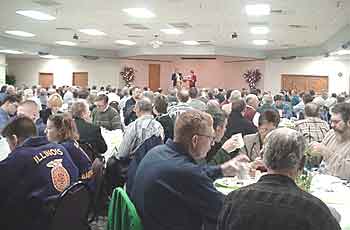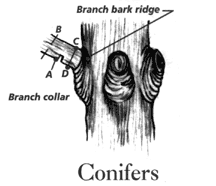|
Features,
Honors
& Awards, Ag
Announcements
Ag News Elsewhere
(fresh daily from the Web)
|
|
Features
|
|
Alternative
fuels and proposed ethanol plant are topics at Ag Day breakfast
[MARCH
21, 2002] Fuels
derived from corn and soybeans and a proposed cooperatively owned
ethanol plant in Elkhart were main topics addressed by speakers at
Thursday morning’s third annual Logan County Ag Day breakfast. The
breakfast, at the Knights of Columbus building, was sponsored by the
Lincoln/Logan County Chamber of Commerce Agriculture Committee.
View pictures of the
event
|
|
Keynote
speaker Mike Lockart, marketing manager for propane and alternative fuels at
Growmark, said that 11 to 12 percent of the gasoline used in the United
States contains ethanol, and the focus is now shifting to biodiesel fuels.
He defined these as diesel fuels based entirely on soybean, rice, canola or
sunflower seed oils, used cooking fat, or a combination of these. The
American Society for Testing and Materials has set standards for biodiesel
fuels, an important development because it means engine manufacturers
recognize these fuels as a viable alternative to diesel.

[Photo by Bob Frank]
Speaking
to a crowd that filled the Knights of Columbus hall, Lockart said to expect
a new fuel status soon for ethanol-blended diesel fuel, which Growmark is
currently testing.
He
advised those in the agricultural community to watch the numerous state and
federal bills related to setting a standard for renewable fuel. The
terrorist attacks on Sept. 11 have underscored the hidden price for imported
oil, he said, and the result can help corn and soybean producers as well as
improve air quality.

Ernest
Moody, chair of the Land of Lincoln Agriculture Coalition, said the group
will conduct a membership drive in June and plans to offer stock in the
projected Elkhart ethanol plant beginning in January 2003. Only members of
the coalition will be able to buy the stock. Moody said a membership will
cost $500 in the first year and $100 annually after that. He hopes that a
high percentage of stock will be bought locally and that agricultural
producers will purchase at least 51 percent.
Based
on a U.S. Department of Agriculture formula and the projected size of the
Elkhart plant, Moody estimated that it will generate 1,000 to 1,500 local
jobs.
[to top of second column in
this article]
|

Terry
Lock, chair of the ag work force development subcommittee,
introduced winners of three agriculture scholarships:
• $1,000 to Elizabeth Schilling of Lake Fork, a junior at the University
of Illinois majoring in ag consumer economics.
• $1,000 to Kent Leesman of Atlanta, a Hartem senior who plans to major
in agronomy at the University of Illinois.
• $500 to Michael Stoll of Chestnut, a senior at Mount Pulaski who plans
to major in agriculture and animal science at Lincoln Land Community
College. Stoll expects to transfer to University of Illinois to
complete his bachelor’s degree.
Emergency
Services and Disaster Agency Coordinator Dan Fulscher noted that
agriculture is the industry with the most work-related accidents
nationwide and advised farmers to make sure their employees carry
cell phones and can identify their location. Over 30 percent of all
local 911 calls are cellular, he said, and many of these callers do
not realize that no technology is in place to give their location.
The
chamber ag committee is chaired by Marty Ahrends; Larry Huelskoetter
headed the Ag Day 2002 committee which planned the breakfast.
Master
of ceremonies Dave Hawkinson, director of marketing and public
affairs for Corn Belt Energy, said, "We appreciate all of you
who participate in the agriculture industry" and thanked those
present for the wisdom and commitment they bring to the community.
[Lynn
Shearer Spellman]

|
|
 |
|
|
Logan
County fourth-grade students
will learn ‘Agriculture is Everywhere’
[MARCH
20, 2002] Due
to the weather forecast for March 21, the Logan County Farm Bureau
is postponing its second annual Agriculture is Everywhere Fair.
The event has been rescheduled for Thursday, April 11, at the
Logan County Fairgrounds.
|
|
On
the new date, fourth-grade students from Logan County will attend a half-day
fair to discover how agriculture is a world of opportunities and how
people need agriculture in their daily lives. There will be two
sessions, one from 9 to 11:30 a.m. and another from noon to 2:30
p.m. Participation in the event will be near 100 percent of the
county fourth-graders.
The
students will attend five breakout sessions with hands-on activities. The
sessions include dairy, pork, corn, soybeans, machinery and an agricultural
food sampling. The closing segment will focus on sheep and a shearing
demonstration.
|
At
each station, equipment and live animals will be present to expose the
students to agriculture in Logan County.
Members
of the Hartsburg-Emden, Lincoln and Mount Pulaski FFA chapters will be
present to help educate the area students.
The
schools are also given the opportunity to have their students participate in
an Agriculture is Everywhere essay contest. The top five winners, selected
by Lincoln College Phi Theta Kappa Honorary Society, will receive trophies.
Members of
the Logan County Farm Bureau are organizing the fair in celebration of
National Ag Day.
[Logan
County Farm Bureau]
|
|
|
It’s
time to talk about
how and when to prune
[MARCH
11, 2002] With
the calendar pointing to spring, it’s time to think about
finishing up pruning chores. It doesn’t seem possible that we need
to be gearing up for the outdoor season. But it is time, and one of
the first items of business is pruning.
|
|
Let
me start by saying that pruning is an art rather than a science. There are
some basic rules of pruning that should be followed, and the rest is more
personal taste than scientific fact.
Starting
with the proper tools, you should have bypass hand shears (for cutting twigs
up to one-fourth inch), bypass loppers (for those in-between cuttings of
one-fourth inch to 1¼ inch), and a good pruning saw for larger limbs.
Bypass, rather than anvil-type, pruners are recommended.

Next
for the general rules that should be followed:
1.
Remove dead and broken branches.
2.
Remove diseased branches or diseased parts of branches.
3.
Remove water sprouts (rapidly growing young shoots that grow straight up).
4.
Remove suckers (that grow from roots or at ground level).
5.
Eliminate competition between branches.
6.
Eliminate "v" branching (where two branches of similar size form a
narrow "v").
7.
Remove weak, slow-growing, drooping, non-productive branches.
8.
Remove branches, or parts of branches, that touch the ground.
9.
Avoid selecting main branches that grow toward the direction of prevailing
summer winds (southwest in our case.)
10.
Particularly with fruit trees, do training-only pruning for the first five
years (severe pruning early on will tend to delay fruit onset).
Now
that we have the rules, we need to know when to do pruning. Ornamentals with
high sap-flow rates (such as maples and sweet gums) should be pruned in
December; other ornamentals should be done in February or early March.
Common fruit trees (such as apples and pears) should be done in February or
early March; stone fruits (such as peaches and apricots) are best done after
flowering (since we get a crop only every so often to begin with); and
evergreens are best done in late June.
[to top of second column in
this article]
|
When
making cuts, leave at least a one-sixteenth inch collar for proper
healing. On large branches, make two cuts, with the first leaving a
foot-long stub. These cutting procedures will reduce injury to
tissues in the trunk or main branches. Don’t bother with
"pruning paint." This sealant will not prevent diseases
from entering, since they probably were present as soon as the
branch was cut, and any sap flow will loosen the covering.

There
are a few other things to keep in mind when pruning:
1.
Disinfect pruning tools with rubbing alcohol or bleach solution
between each cut if you suspect diseases that can be transmitted.
2.
Be very careful about pruning apples or mountain ash infected with
fire blight.
3.
Ash trees should not have much pruning done for about 10 years, due
to potential borer infestations.
4.
Expect lots of sap flow this year on most things due to the warm
winter we have had. This actually makes us feel worse than the
effect on the plant.
For
all you grape growers, the February or early March period is a good
time to prune grapes. Train them to your trellis by leaving three
good buds per branch. This number of good buds promotes grape and
cluster size.
A
final rule of thumb is this: "If you think you pruned too much,
you’re about right!"
[John
Fulton]
|
|
|
Illinois
ag leaders visiting Asia
Class diary for the 2002 International
Travel Seminar
[MARCH
8, 2002] Illinois
Ag Leadership Foundation has launched its 2002 International Travel
Seminar. The trip allows Illinois agricultural leaders to
experience and understand agricultural issues on a global
scale. This year the group has gone to China. One
of the participating delegates is Marty Ahrends of
Lincoln.
[Click
here to follow the group to Beijing, China, and beyond.]
[LDN]
|
|
|
Farm
Foundation involved in $2 million study in agricultural
biotechnology
[MARCH
5, 2002] Farm
Foundation, based in Oak Brook, is one of the collaborating
institutions receiving a $2 million grant from the U.S. Department
of Agriculture for a national study of university-industry
relationships in agricultural biotechnology. The grant is funded
from the Initiative for Future Agriculture and Food Systems under
USDA’s Cooperative State Research, Education and Extension
Service.
|
|
The
three-year project, "Public Goods and University-Industry Relationships
in Agricultural Biotechnology," will assess university-industry
research, licensing and other partnerships, with special emphasis on the mix
of public and private goods provided through agricultural biotechnology.
While the project will be headquartered at Portland State University and
headed by Project Director Dave Ervin, a professor in Portland State
University’s Environmental Sciences and Resources Program, Farm Foundation
will have a major role in disseminating project findings to policymakers and
private sector decision-makers.
"With
agricultural biotechnology research being carried out increasingly in the
private sector, often in collaboration with university researchers,
questions about the relationships between universities and companies to
develop agricultural biotechnology products are the subject of much
speculation and little scientific information. Farm Foundation is pleased to
be involved with one of the first studies to improve our understanding of
the relationships, their effects on products and appropriate policies to
address any potential issues," according to Walter J. Armbruster,
president of Farm Foundation.
[to top of second column in
this article]
|
Farm
Foundation’s mission is to improve the economic and social
well-being of U.S. agriculture and rural people by helping public
and private sector decision-makers identify and understand forces
that will shape the future.
Agricultural
biotechnology has the potential to improve production and human
health and reduce pollution. The project investigators will
interview university and industry personnel; conduct a survey of
university scientists, technology officers and administrators; and
undertake socioeconomic analysis to identify problems and potential
policies to foster the development of products with traits that
promote widespread public benefits. Project findings will inform key
stakeholders about the manner in which agricultural biotechnology
research is planned, coordinated and rewarded; and stimulate
constructive dialogue among academics, commercial firms and
policymakers.
[Farm
Foundation news release]
|
|
|
Honors
& Awards
|
|
Hartem
FFA wins ag sales contest
[MARCH
18, 2002] The
Hartsburg-Emden FFA agriculture sales team placed first in a recent
agriculture sales contest.
|
|
Individuals
placing first were Natalie Coers for newspaper advertisement, Krista
Ubbenga for product display, and Kent Leesman in customer relations.
Placing
second were Matthew Wrage in sales presentation and Kyle Hoerbert in
telephone skills.
Kent
and Natalie also tied for the highest score on the written test.
As
a team, Hartem was first in market analysis.
[Hartsburg-Emden
FFA report]
|

[Hartem ag sales team: Matt
Wrage, Natalie Coers, Kent Leesman, Krista Ubbenga and Kyle Hoerbert]
|
|
|
Lincoln
FFA members advance in two competitions
[MARCH
13, 2002] The
Lincoln FFA chapter recently participated in two competitions.
|
|
The
first was the Section 14 public speaking contest. Three individuals
from Lincoln participated: Bobbi Hartwig in creed speaking, Brittany
Ingram in varsity prepared and Emily Bakken in varsity
extemporaneous. Everyone did a great job. Emily placed second in her
area and will advance to district competition April 3 on the Western
Illinois University campus.
|
Two
Lincoln members also participated in the District 3 record books
competition at Jacksonville High School on March 6. Amanda Davison
competed in specialty animal production placement, and Emily Bakken
competed in specialty animal production entrepreneurship. Emily won
her area and will compete at state on March 23 at the University of
Illinois. Both girls did an excellent job.
Mr.
Scott Nordstrom is the adviser for the students.
[Lincoln
FFA report]
|
|
|
Ag
Announcements
|
|
Ag
scholarship announced
[FEB.
18, 2002] The
Midwest Equipment Dealers Association, through its educational
foundation, Midwest Equipment Foundation, will provide two $1,000
scholarships and four $750 scholarships for the 2002-03 school year
to students enrolled in association-approved community college
training programs.
A
copy of the scholarship announcement brochure with scholarship
rules, application form and listing of approved training programs
has been provided to all high school vo-ag instructors and community
colleges that provide MEDA-approved training programs.
The deadline for scholarship applications is April 1.
Scholarship
information can also be picked up at Central Illinois Ag’s Atlanta
store, 200 Sharon St., 1 (800) 762-2325, or from MEDA directly at 1
(800) 236-6332.
[News
release]
|
|
|